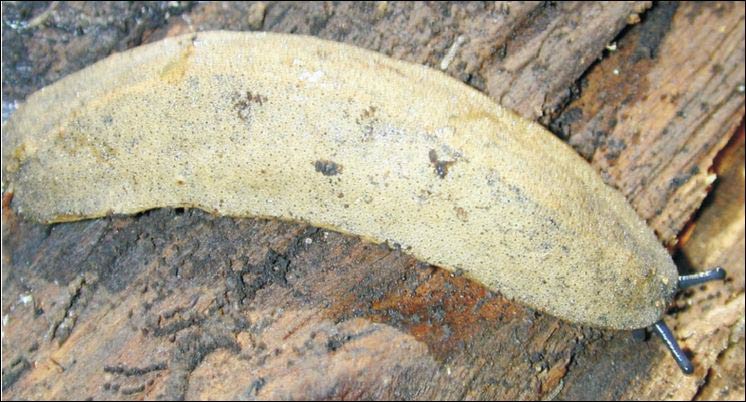Veronicellidae: Phyllocaulis gayi
|
Phyllocaulis gayi. (Photo: © S. Rodrigues Gomes, Academy of Natural Sciences) |
|
Phyllocaulis gayi: penis. (Photo: © S. Rodrigues Gomes, Academy of Natural Sciences) |
Family
Veronicellidae
Species
Phyllocaulis gayi (Fischer, 1871)
Common name
None reported.
Description
This pale, tan-colored slugSlug:
A snail that either does not possess a shell or has one that is very reduced (no definite coiling) or internal.
can get as large as 100 mm long and 20 mm wide. It typically has a cream colored-colored line running the entire length of the body. There may be grey speckling on its dorsum, creating a greyish-colored animal. The tentaclesTentacles:
Sensory projections on the head end of a mollusc. There are generally two pairs; upper (posterior) and smaller, lower (anterior). The upper pair bears the eyes. In many snails the eyes are located at the tips of this structure; however, in Basommatophoran snail species, the eyes are located at the base of the tentacles.
appear blue or silver in color.
Native range
South America
Distribution
South and Central America: Mexico, Chile
Ecology
This granivorous (seed eating) species has been observed feeding on the seeds of the peanut plant (Arachis hypogea), and that of the trees Cryptocarya alba and Aetoxicum punctatum. This species may be considered an ecological pest, especially in forest regeneration.
Synonyms
- Vaginula gayi Fischer, 1871 in Fischer, 1871. Revision des especes du genere Vaginula Ferussac. Nouvelles Archives du Museum d'Historie Naturelle. Paris. 7: 147-175.
- Vaginula (Phyllocaulis) gayi Fischer, 1871 in Baker, 1925. North American Veronicellidae. Proceedings of the Academy of Natural Sciences of Philadelphia. 77: 157-184.
- Phyllocaulus gayi (Fischer, 1871) in Thome, 1971. Redescricao dos tipos de Veronicellidae (Mollusca, GastropodGastropod:
A single-shelled mollusc.
) neotropicais: VII especies depositadas no Museum National d'Histoire Naturelle, Paris, Franca. Iheringia (Zool.) 40: 27-52.
References
Naranjo-García et al. 2007Naranjo-García et al. 2007:
Naranjo-García, E., J. Thomé and J. Castillejo. 2007. A review of the Veronicellidae from Mexico (Gastropoda: Soleolifera). Revista Mexicana de Biodiversidad. 78: 41-50.; Rodrigues Gomes et al. 2009Rodrigues Gomes et al. 2009:
Rodrigues Gomes, S., F. Britto da Silva, I. Vietenheimer Mendes, J. Willibaldo Thomé and S. Bonatto. 2009. Molecular phylogeny of the South American land slug Phyllocaulis (Mollusca, Soleolifera, Veronicellidae). Zoologica Scripta. 39: 177-186.; Simonetti et al. 2003Simonetti et al. 2003:
Simonetti, J.A., A.A. Grez and R.O. Bustamante. 2003. Phyllocaulis gayi (Pulmonata: Systellommatophora): A neglected granivore in the Chilean Temperate forest? Gayana. 67(1): 114-116.; Thome 1989Thome 1989:
Thome, J.W. 1989. Annotated and illustrated preliminary list of the Veronicellidae (Mollusca: Gastropoda) of the Antilles, and Central and North America. Journal of Medical and Applied Malacology. 1: 11-28.



